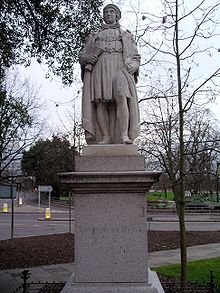Thomas White (merchant)
Sir Thomas White (b. 1492 in Reading, Berkshire; † 12 February 1567 at Gloucester Hall, Oxford University, Oxfordshire) was an English textile merchant, Lord Mayor of London, and founder of St John's College, Oxford and Merchant Taylors' School in London.
Thomas White was the son of William White, a draper of Rickmansworth in Hertfordshire, and his wife Mary, daughter of John Kebblewhite of South Fawley in Berkshire. At the age of twelve he was apprenticed to Hugh Acton, a prominent member of the Merchant Taylors' Company. His master having left him a modest legacy on his death in 1520, he set up in business for himself in the drapery business in 1523, and continued in that capacity until circa 1535, when he was able to purchase the Merchant Taylors' Company.
From this time he also acted as a benefactor. In 1542 and 1545 he granted large loans to the cities of Coventry and Bristol, and supported the parish of St. Michael, Cornhill, of which he was a member, and which elected him alderman in 1544. In 1547 he became county bailiff. In 1561 he entered into a trust in the name of his company for the benefit of the city of Coventry, which was to receive generous funds for charitable and benevolent purposes after his death. On 2 October 1553, in the presence of Queen Mary, he was knighted by the Earl of Arundel, and thus raised to the peerage. On 29 October of the same year he was appointed Lord Mayor of London. The pomp and pageantry of the procession on the occasion of his investiture have been handed down. His time as mayor was marked by various proclamations and laws against gambling and dancing.
Also in 1553 he was a member of the judicial commission in the trial of Lady Jane Grey her followers.
After this task ended, White concentrated on charitable projects outside the city. His friend, Sir Thomas Pope (1507-1559) had recently founded Trinity College in Oxford, which inspired him to found a college himself in the city where he already held lands. On 1 May 1555 he received royal permission to run a college 'for the learning of the sciences of holy divinity, philosophy and good arts', to be dedicated to the Blessed Virgin Mary and St John Baptist (the patron saint of the Merchant Taylors' Company).
In 1559 White acquired Gloucester Hall, where he spent the last years of his life. From 1562 he suffered increasingly from the crisis in the cloth industry and got into financial difficulties. Nevertheless, he was able to continue to set up various trusts for the benefit of various towns, London cloth companies and his own dependents.
When White died on February 12, 1567, he was a poor man. Much of the money he gave to his college or other social causes never reached its destination, but was consumed by intermediaries, trustees, and other associates.
Sir Thomas was twice married. His first wife, Avicia, whose surname is unknown, died on 26 February 1558. On 25 November of the same year he married Joan, the daughter and joint heiress of John Lake of London and the widow of Sir Ralph Warren. He had no descendants.
Sir Thomas White is sometimes confused with his namesake Sir Thomas White of South Warnborough in Hampshire, who was raised to the peerage on the same day and whose wife was called Agnes. The confusion is all the more understandable as the lands of this Thomas White in South Warnborough also became part of the estate of St John's College. This, however, was due to a gift from Archbishop Laud, who had received the lands from William Sandys in 1636.

Statue of Thomas White in Coventry

Sir Thomas White, 18th century copperplate engraving
Search within the encyclopedia